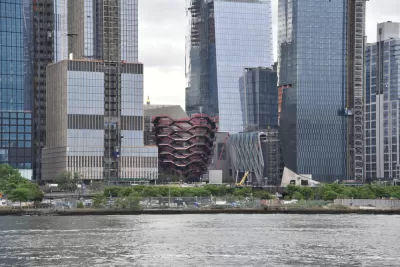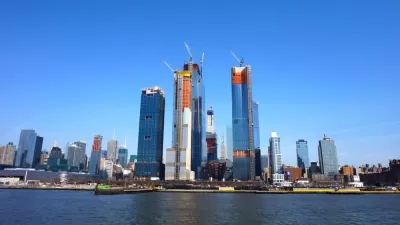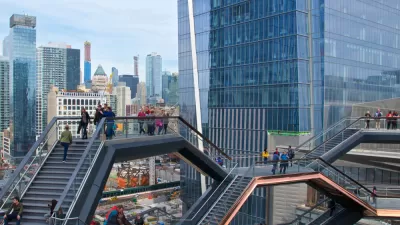The size and scale of Hudson Yards in the skyline of Manhattan will match the size and scale of public and private investment in the project. The project's effect in the city's economy will be just as conspicuous.

Greg David says there's a big angle to the story about the Hudson Yards project in New York City that is going unnoticed amidst a dispute between unions and developer The Related Cos.
The bigger story is the way Hudson Yards has—faster than anyone expected—fulfilled the two goals of the government officials who set it in motion: create capacity for the New York economy to expand and revive a moribund waterfront section of Manhattan. Its success can be attributed to more than $600 million in direct public investment and a very lucrative tax break.
The first phase of Hudson Yards, built with more than $18 billion in equity and debt over a storage and maintenance yard for Long Island Rail Road trains, will open to the public next March 14, Related says. The numbers couldn't be more impressive. The developer has leased or sold 7 million square feet of office space to tenants ranging from luxury accessories specialist Tapestry to ad agency BCG to media giant Time Warner to BlackRock, the largest money manager in the world. Some 55,000 thousand people will work there every day.
The article includes a history of the project, from its early days as a cornerstone in the Bloomberg Administration's pitch to bring the Olympics to New York City in 2012 (the games were ultimately played in London) to the big public investments that have set the stage for the success of Hudson Yards.
FULL STORY: The story of Hudson Yards is now the story of New York

Alabama: Trump Terminates Settlements for Black Communities Harmed By Raw Sewage
Trump deemed the landmark civil rights agreement “illegal DEI and environmental justice policy.”

Study: Maui’s Plan to Convert Vacation Rentals to Long-Term Housing Could Cause Nearly $1 Billion Economic Loss
The plan would reduce visitor accommodation by 25% resulting in 1,900 jobs lost.

Why Should We Subsidize Public Transportation?
Many public transit agencies face financial stress due to rising costs, declining fare revenue, and declining subsidies. Transit advocates must provide a strong business case for increasing public transit funding.

Paris Bike Boom Leads to Steep Drop in Air Pollution
The French city’s air quality has improved dramatically in the past 20 years, coinciding with a growth in cycling.

Why Housing Costs More to Build in California Than in Texas
Hard costs like labor and materials combined with ‘soft’ costs such as permitting make building in the San Francisco Bay Area almost three times as costly as in Texas cities.

San Diego County Sees a Rise in Urban Coyotes
San Diego County experiences a rise in urban coyotes, as sightings become prevalent throughout its urban neighbourhoods and surrounding areas.
Urban Design for Planners 1: Software Tools
This six-course series explores essential urban design concepts using open source software and equips planners with the tools they need to participate fully in the urban design process.
Planning for Universal Design
Learn the tools for implementing Universal Design in planning regulations.
Smith Gee Studio
Alamo Area Metropolitan Planning Organization
City of Santa Clarita
Institute for Housing and Urban Development Studies (IHS)
City of Grandview
Harvard GSD Executive Education
Toledo-Lucas County Plan Commissions
Salt Lake City
NYU Wagner Graduate School of Public Service





























